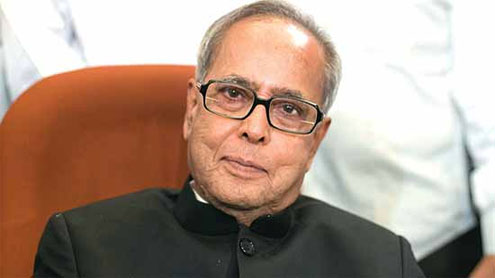
NEW DELHI: Pranab Mukherjee is all set to be the 13th President of India. Sonia Gandhi announced his candidature on Friday evening after a brief meeting of the UPA.
It put an end to the long suspense that marked the rollercoaster race for the nomination of its presidential candidate by the ruling alliance.Mukherjee is expected to win the contest hands down, with SP and BSP pledging their support and the Left likely to follow suit. They, along with the UPA, account for a majority in the electoral college. The advantage promises to become overwhelming with cracks showing up in the BJP-led NDA over opposition to Mukherjee’s candidature.
BJP’s ally JD(U) is arguing against a contest by citing the stature of the veteran politician and the need to avoid acrimony over a losing battle. In fact, with former President A P J Abdul Kalam unlikely to enter the fray, the election may become just a formality. The denouement marked a rather satisfactory outcome for the Congress – its leader Sonia Gandhi, in particular, who succeeded in calling TMC chief Mamata Banerjee’s bluff. The party was keen to have its nominee installed in Rashtrapati Bhavan but was handicapped by adverse mathematics in the wake of the UP poll debacle and Mamata Banerjee’s dogged opposition to the finance minister.
‘Corporates happy to see Pranab’s back’
There’s been widespread talk within corporate India of “the return of a raid raj where every small thing comes under the lens of the taxman, the excise inspector, or ED”, to use the words of a prominent businessman.
At the same time, Mukherjee’s stature and seniority made it difficult for anyone, including even the PM, to intervene. The corridors of power have been abuzz with rumours of a communication gap between the PMO and North Block. Even multinational CEOs have spoken in private about feeling more welcome and wanted at the PMO than at North Block. Mohandas Pai, who was a senior board member of Infosys, said on TV on Friday, “Corporate India is happy to see his (Pranab’s) back.” It’s been said in hushed tones that the PM may see this as a win-win – Mukherjee moves out of North Block, and into a job he coveted.
As and when he does hand over charge of the ministry, Congressmen believe it will be to a politician and not a bureaucrat like C Rangarajan or Montek Singh Ahluwalia – especially not with polls on the horizon. Names of several ministers, from Jairam Ramesh to Kamal Nath, have been doing the rounds, but many rate P Chindambaram’s chances of returning to a job he’s twice held and is said to feel an affinity for.
Sonia’s next challenge: Finding leader of the House
In the event, it pulled off a political feat by getting both SP and BSP to endorse its nominee, while isolating Mamata who teamed up with Mulayam Singh only to fall flat. In a dramatic sequence of events, Mulayam played along with Mamata but reversed gears in time to bail out the UPA.
It was a crowning moment for Mukherjee, a politician with more than five decades in public life. For seven years since the advent of UPA, the veteran was rankled by the fact that despite being the oldest Congress insider in the ruling dipsensation, he had to report to Manmohan Singh, a rank outside whom he appointed as RBI governor So, it was a ‘righting of protocol’ in many ways when Sonia Gandhi at 4.40pm, announced that the finance minister would be the ruling combine’s candidate for the President’s election. Being the Head of State, the President figures on the top of the hierarchy and with powers, technically speaking, to appoint the Prime Minister.
With the hunt for the next President over, Congress leadership is now faced with the job of finding who can fill “Dada’s” big shoes. Sonia needs to find a Leader of the House in Lok Sabha as well as a new finance minister.
Then, there is the task of making new heads for GOMs and EGoMs that Mukherjee headed, not to speak of finding a political troubleshooter of his caliber. Home minister P Chidambaram will be required to do some heavy lifting and is considered to be among the probables for the role of the Leader of House.Mukherjee’s arrival in Rashtrapati Bhavan will also transform the imposing colonial building into more than a ceremonial edifice.His tenure will mark a break from the recent pattern of elevating technocrats (A P J Abdul Kalam) or political lightweights (incumbent Pratibha Patil) to the top constitutional post.
Though titular in the constitutional scheme, the President’s role has often been crucial, often innovative, with the occupants interpreting it in diverse ways. Close electoral results and coalition politics have added to the interest in the office. With Congress succeeding in luring Mulayam to its fold after the SP chief briefly threatened to join hands with Mamata, the announcement of Mukherjee’s candidature was a mere formality. It was completed swiftly just after Sonia Gandhi sought the endorsement of UPA allies.
NCP boss Sharad Pawar said that Mukherjee should straightaway be declared the candidate if we have “SP and BSP on board”. “Yes, we have their support,” said Pranab Mukherjee, leading to the formal declaration.The announcement saw both the Prime Minister and Mukherjee working phones to seek support for his unanimous election. The President-designate was quite statesmanlike as he parried questions about Trinamool chief’s bitter opposition to him. “I will also seek her support. She is like my sister,” said Mukherjee. – TOI












